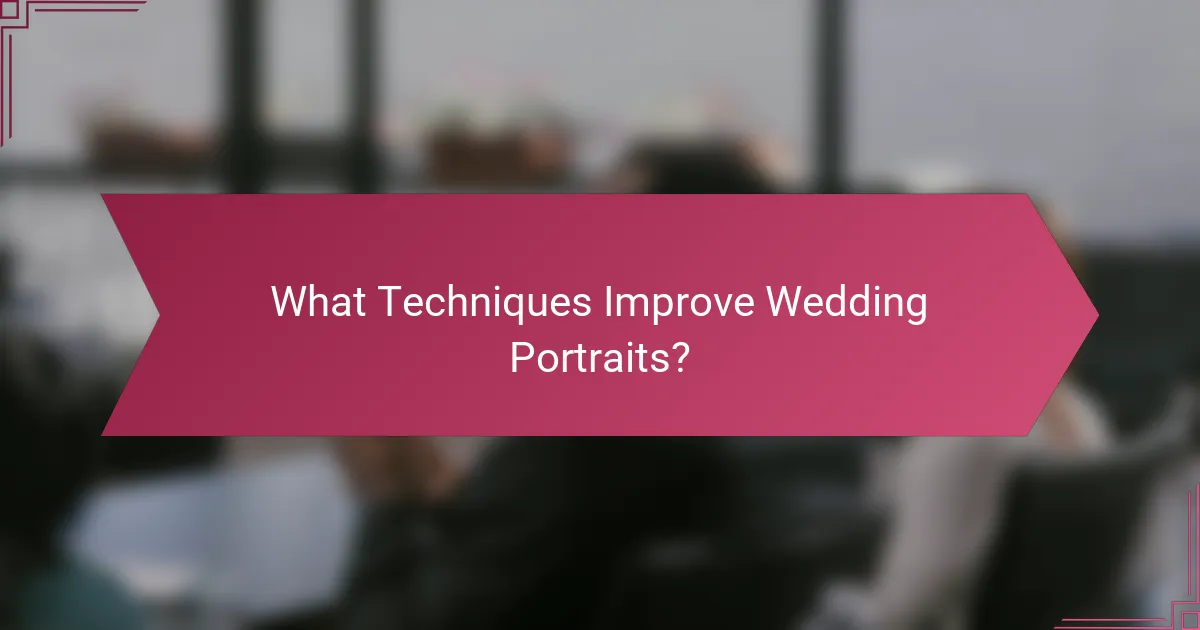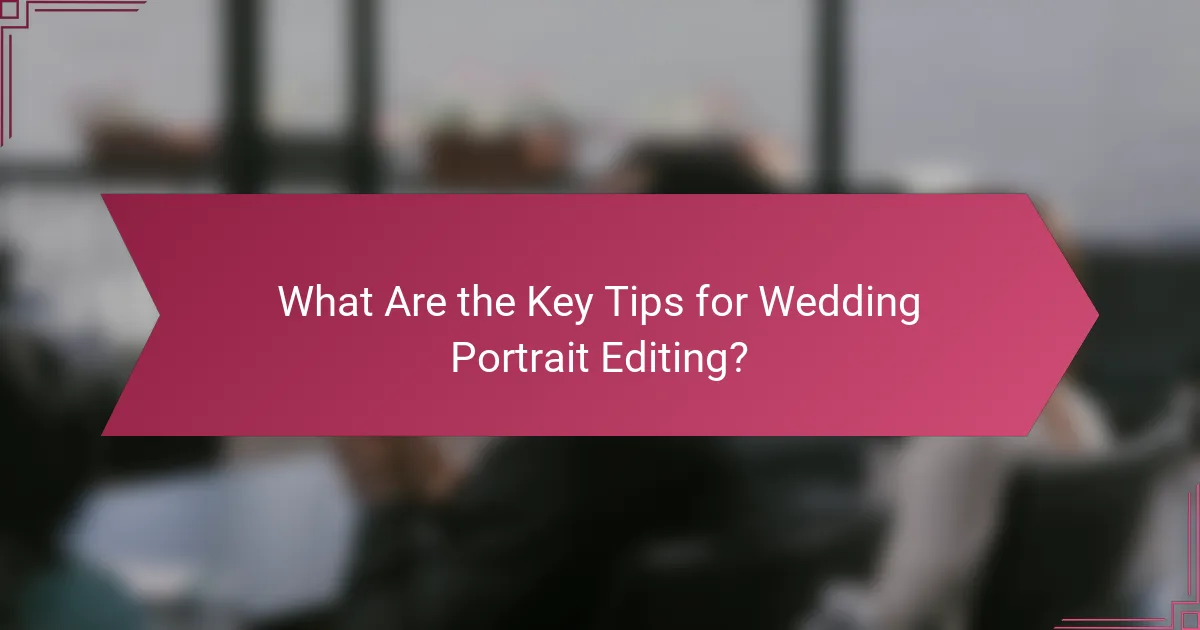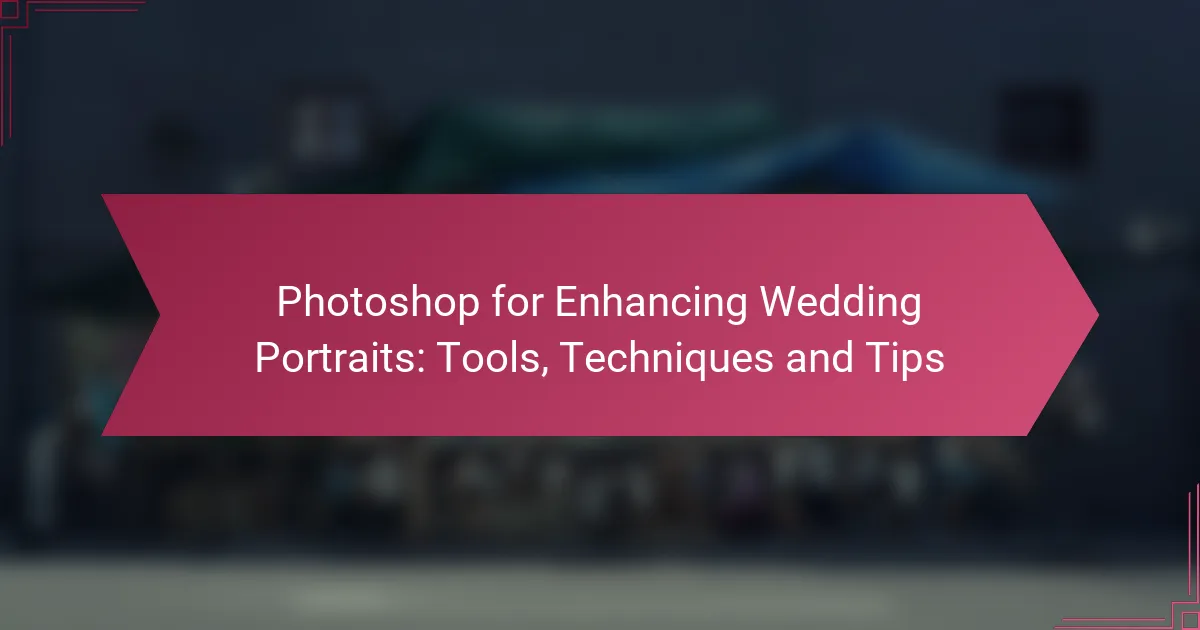Photoshop is an invaluable tool for enhancing wedding portraits, enabling photographers to refine and elevate their images to stunning levels. By utilizing essential tools such as Adobe Camera Raw, Photoshop Actions, and various retouching techniques, you can achieve a polished final product that captures the beauty of the special day. From skin smoothing to color correction, mastering these techniques will significantly enhance the emotional impact of your wedding photography.

What Are the Best Tools for Enhancing Wedding Portraits in Photoshop?
The best tools for enhancing wedding portraits in Photoshop include Adobe Camera Raw, Photoshop Actions, the Portraiture Plugin, Frequency Separation Technique, and Adjustment Layers. Each of these tools offers unique capabilities that can significantly improve the quality and aesthetic of wedding images.
Adobe Camera Raw
Adobe Camera Raw (ACR) is a powerful tool for processing raw images and making initial adjustments. It allows photographers to fine-tune exposure, contrast, color balance, and sharpness before importing images into Photoshop.
Utilizing ACR can streamline your workflow by enabling batch processing, which is particularly useful for wedding photographers dealing with numerous images. Use sliders to adjust highlights and shadows, ensuring that details in both bright and dark areas are preserved.
Photoshop Actions
Photoshop Actions automate repetitive tasks, saving time and ensuring consistency across wedding portraits. By recording a series of adjustments, you can apply them to multiple images with a single click.
Create custom actions for common enhancements like skin smoothing or color correction. This not only speeds up your editing process but also helps maintain a cohesive look throughout the wedding album.
Portraiture Plugin
The Portraiture Plugin is designed specifically for skin retouching, making it easier to achieve a flawless look in wedding portraits. It intelligently smooths skin while preserving important details like texture and features.
When using this plugin, adjust the strength of smoothing to avoid an overly airbrushed appearance. A subtle touch often yields the most natural results, enhancing beauty without losing authenticity.
Frequency Separation Technique
Frequency Separation is a retouching technique that separates an image into two layers: one for color and another for texture. This allows for precise adjustments to skin tones while maintaining the natural texture of the skin.
To implement this technique, create two duplicate layers of your image, applying a Gaussian blur to one for color and leaving the other untouched for texture. This method requires practice but can yield stunning results when done correctly.
Adjustment Layers
Adjustment Layers in Photoshop provide a non-destructive way to edit images, allowing you to modify brightness, contrast, and color without altering the original photo. This flexibility is crucial for fine-tuning wedding portraits.
Common adjustment layers to consider include Levels, Curves, and Hue/Saturation. Use these layers to enhance specific areas of the image, ensuring that the final portrait is vibrant and true to the couple’s special day.

How to Use Photoshop for Wedding Portrait Retouching?
Photoshop is an essential tool for enhancing wedding portraits, allowing photographers to refine images and create stunning visuals. Effective retouching involves a combination of basic adjustments, skin smoothing, and color correction techniques to achieve a polished final product.
Basic Retouching Steps
Start with basic retouching by cropping the image to improve composition and removing any distracting elements. Use the healing brush or clone stamp tools to eliminate blemishes, stray hairs, or unwanted objects in the background.
Next, adjust the exposure and contrast to enhance the overall brightness and depth of the portrait. Utilize the Levels or Curves adjustments to fine-tune highlights and shadows, ensuring the subject stands out beautifully against the background.
Skin Smoothing Techniques
Skin smoothing is crucial for creating a flawless appearance in wedding portraits. Begin by duplicating the layer and applying a Gaussian Blur to the new layer, then use a layer mask to selectively reveal the blurred effect on the skin areas.
Alternatively, consider using the Frequency Separation technique, which separates texture from color. This allows for more precise control over skin tones while maintaining natural skin texture. Aim for a subtle effect to avoid an overly airbrushed look.
Color Correction Methods
Color correction is vital for achieving accurate skin tones and vibrant colors in wedding portraits. Start by adjusting the white balance to eliminate any color casts, ensuring that whites appear neutral and colors are true to life.
Utilize the HSL (Hue, Saturation, Lightness) panel to fine-tune specific colors, enhancing the vibrancy of flowers or the wedding dress without altering skin tones. Regularly compare your adjustments to the original image to maintain a natural look.

What Techniques Improve Wedding Portraits?
Improving wedding portraits involves a combination of lighting adjustments, background enhancements, and sharpening techniques. Each of these elements can significantly elevate the overall quality and emotional impact of the images.
Lighting Adjustments
Lighting is crucial in wedding photography, as it sets the mood and highlights the subjects. Utilize natural light whenever possible, especially during golden hour, which provides soft, warm tones. If shooting indoors, consider using softboxes or reflectors to diffuse harsh light and create a flattering glow.
When adjusting lighting in Photoshop, use tools like the Brightness/Contrast and Levels adjustments to fine-tune exposure. Be cautious not to overexpose highlights or underexpose shadows, as this can lead to loss of detail.
Background Enhancements
The background can make or break a wedding portrait. Ensure the background complements the couple without distracting from them. Use Photoshop’s selection tools to isolate the subject and apply blur effects to the background, creating a depth-of-field effect that draws attention to the couple.
Consider adjusting the colors of the background to harmonize with the wedding theme. Tools like Hue/Saturation can help shift colors subtly, enhancing the overall aesthetic without overwhelming the main subjects.
Sharpening Techniques
Sharpening is essential for bringing out details in wedding portraits. Use the Unsharp Mask or Smart Sharpen filters in Photoshop to enhance the clarity of the subjects. Start with low amounts and adjust the radius to avoid introducing noise or artifacts.
It’s advisable to apply sharpening selectively, focusing on the eyes and key details while leaving softer areas untouched. This approach ensures that the portrait maintains a natural look while still appearing crisp and well-defined.

What Are the Key Tips for Wedding Portrait Editing?
Key tips for wedding portrait editing include maintaining a natural look, using presets effectively, and optimizing your workflow. These strategies help enhance images while preserving the authenticity of the moment captured.
Maintaining Natural Look
To keep wedding portraits looking natural, focus on subtle adjustments rather than heavy edits. Aim for skin tones that reflect reality; avoid over-saturation or excessive smoothing. Use tools like the healing brush for blemishes and the dodge and burn technique to enhance features without altering their essence.
Consider the overall color palette of the wedding. Adjust the white balance to ensure that colors appear true to life. A good rule of thumb is to compare your edits with the original images to ensure the final product remains authentic.
Using Presets Effectively
Presets can save time and provide a consistent look across wedding portraits. However, it’s crucial to customize them to fit the specific lighting and mood of each photo. Start with a preset that aligns with your style, then tweak exposure, contrast, and color settings as needed.
When applying presets, be mindful of their impact on skin tones and backgrounds. A preset that works well in one setting may not suit another. Always review and adjust after applying to ensure the final image meets your quality standards.
Workflow Optimization Tips
Streamlining your editing workflow can significantly reduce time spent on wedding portraits. Organize your files into folders by event or date, and use batch processing for similar images to apply adjustments quickly. This approach can save you considerable time during peak wedding season.
Utilize keyboard shortcuts in Photoshop to speed up your editing process. Familiarize yourself with essential commands for tools you use frequently. Additionally, consider creating a checklist of common edits to ensure consistency and efficiency across all portraits.

How to Choose the Right Photoshop Tools for Your Needs?
Selecting the right Photoshop tools for enhancing wedding portraits depends on your skill level and specific requirements. Understanding the available tools and their functionalities will help you make informed decisions that can elevate your editing process.
Assessing Your Skill Level
Your skill level in Photoshop significantly influences the tools you should choose. Beginners may find basic tools like the Crop Tool and Healing Brush sufficient, while more advanced users might prefer using layers, masks, and adjustment layers for detailed edits.
Consider taking online tutorials or courses to gauge your proficiency. This will help you identify which tools you can effectively use and which ones may require further practice.
Identifying Specific Needs
Determine what aspects of wedding portraits you want to enhance, such as color correction, skin retouching, or background adjustments. For instance, if you need to correct lighting issues, tools like Curves and Levels are essential.
Make a checklist of your editing goals. This could include improving skin tones, removing distractions, or adding artistic effects. Prioritizing these needs will help you focus on the most relevant tools and techniques.
